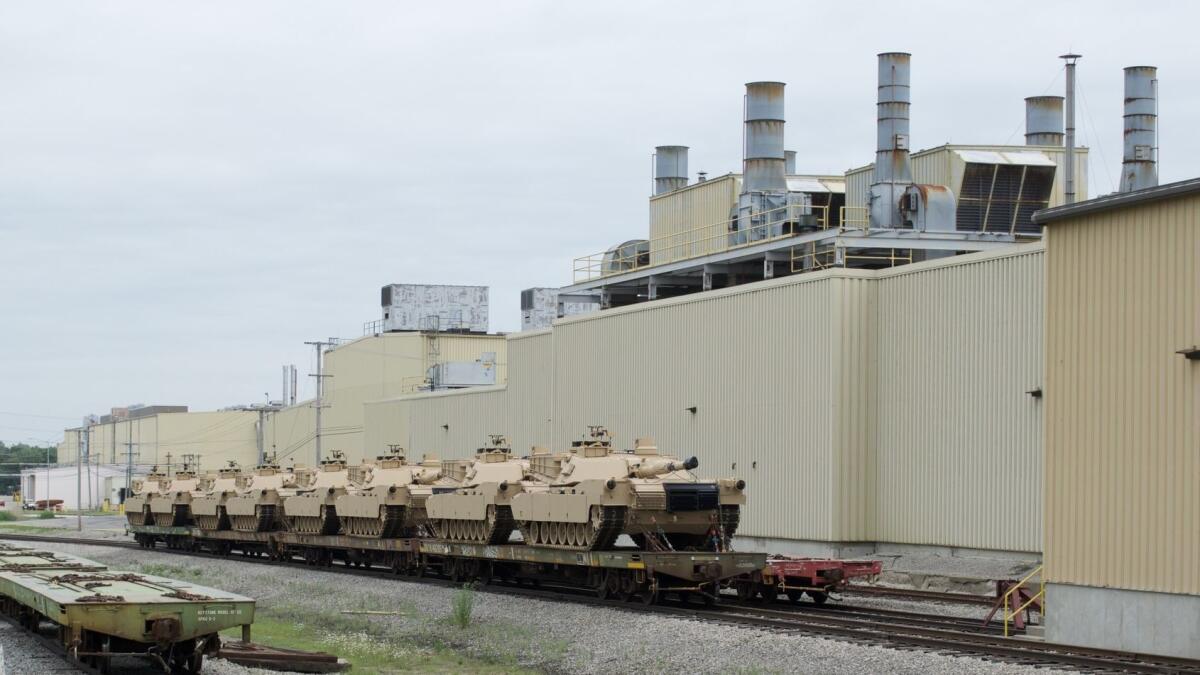Fat Pentagon budget brings jobs to struggling Ohio tank factory — and a political payoff for Trump

- Share via
Reporting from Lima, Ohio — They come in as “rusties”— corroded steel tank hulls mothballed and left for dead years ago.
But after an overhaul by newly hired welders and machinists at a Pentagon-owned factory here in northwestern Ohio, they roll off the assembly line as new 80-ton Abrams M1A2 tanks for the U.S. Army.
The Lima tank plant, a sprawling complex that began building tanks in the early days of World War II, and nearly closed five years ago, is booming these days thanks to more than $2 billion authorized for the armored vehicles in a record Pentagon budget.
The factory turns out 11 upgraded Abrams tanks a month now, up from just one per month a year ago — perhaps the clearest example of how sharp military spending hikes under President Trump are cascading through the economy.
“A couple years ago, there were a lot of people worried about the plant closing,” said Brian Hahn, a plant executive. “Now it looks a lot better to the guys on the floor.”
The decision to upgrade the “rusties” is an abrupt shift for the Army, which six years ago told Congress it didn’t need more Abrams tanks because the heavy armored vehicles were of limited value in the unconventional wars it was fighting against militant groups and insurgents.
The story of the aging tank plant’s revival also highlights the importance of Pentagon spending to Trump’s reelection prospects — and the limits of that strategy.
Trump won Ohio easily in the 2016 election, far out-polling Hillary Clinton in rural areas and small towns like Lima. It remains a critical battleground for 2020 amid Republican fears the state could swing to the Democrats unless Trump can deliver jobs for tens of thousands of blue-collar workers.
The Lima plant, America’s last major tank factory, is an industrial throwback. It has 60-foot-high ceilings, massive cranes, lasers and presses for moving, flipping and cutting the steel plates, hulking tank bodies and turrets that move along an assembly line.
Trump’s support was on display on a recent morning shift as giant overhead cranes transported the solid steel hulls down a line manned by dozens of workers. Some wore olive green United Auto Worker T-shirts with Trump’s “Drain the Swamp” slogan printed on the back.
General Dynamics Land Systems, based in Sterling Heights, Mich., makes the Abrams and operates the plant for the Pentagon. It has been advertising for welders, machinists and other positions. Its recruiters have fanned out to job fairs in Indianapolis; Dayton, Ohio; and Cincinnati.
“It’s very possible we’ll see new residents moving in to fill those jobs,” said David J. Berger, the mayor of Lima, a city of 83,000 that has lost an estimated 8,800 defense industry jobs since the mid-1990s. “These are high-paying, skilled jobs, and anybody with welding skills will be tempted by those openings.”
A June survey by Quinnipiac University found that Ohio voters disapprove of Trump’s performance by a margin 54 to 43 percent, with a three percentage-point higher disapproval rating among independent voters.
After years of fighting insurgents and guerrillas in Iraq, Afghanistan and elsewhere, a new national security strategy last year called for the Pentagon to shift its focus back to preparing for conventional war against Russia, China or other major military powers. Trump proposed large hikes in Pentagon spending for new warships, fighter jets, tanks and other hardware, a boon to defense plants and contractors across the country.
Employment at the Lima plant has doubled from 300 to 600 in the last two years. It’s still far short of the 3,800 jobs here during the Reagan-era defense buildup in the 1980s, but it’s likely to rise as production ramps up from Trump’s military spending binge.
“Our workforce goes up and down and sometimes it is hard to maintain a specialized workforce when you are constantly going from 1,000 employees to 300 employees and vice versa,” said Craig Mack, President of UAW Local 2147, which represents workers at the plant.
The plant has been on life support for so long that many workers who have been laid off have moved away or retired, officials said. All the names on the union’s roster of laid-off workers have already been rehired, officials said.
“The threat of loss of income due to layoff has for many years now lingered heavy over our membership,” said Henry Bertog Jr., a plant worker and union official. ”With the incoming Abrams work that threat is greatly diminished.”
The money started flowing after Trump’s advisors crafted a plan last year to build an upgraded version of the Abrams tank, which was first developed in the Cold War and been improved several times since. Ohio Sens. Rob Portman, a Republican, and Sherrod Brown, a Democrat, pushed through a $1.08-billion appropriation for the latest version of the Abrams tank.
Another $1.5 billion is working its way through Congress this year.
That’s enough to pay for at least 205 redesigned tanks, which have been equipped with a new radio system, an improved generator to run new electronics gear, better armor and a device that allows the tank gunner to electronically change the settings on rounds fired by the main gun.
“Countries around the world, including potential adversaries, continue to invest in armor and anti-armor systems that challenge the strength and supremacy of our armor brigades,” Portman said when Congress approved the money in March. “The newest Abrams tank” is “designed to combat these advancements.”
But critics say the latest upgrade is too costly, does not substantially improve the tank’s lethality, and increases its weight to close to 80 tons — nearly too heavy for Army transport trucks, not to mention many bridges and other infrastructure.
“If it doesn’t add new capabilities, then we’re just throwing good money away, and I’m afraid that’s what we’re doing here,” said Dan Grazier, a former Marine tank officer now with the Project on Government Oversight, a Washington nonprofit organization critical of Pentagon spending.
The Abrams has been the Army’s only battle tank since the 1980s, seeing service in the 1991 Gulf War and the 2003 invasion of Iraq. It has been used in far smaller numbers in Afghanistan and in the occupation of Iraq. Hundreds have been sold to Saudi Arabia, Egypt and other U.S. allies.
The Lima facility has built them since the beginning, through decades of boom and bust. The plant stayed afloat after 2012 by retooling to produce troop-carrying wheeled Stryker vehicles for the Army.
But the last Abrams built from scratch was in 1996. Since then, when upgrades have been made to the tank, the Army would bring retired tanks out of storage and send these so-called “rusties” to Lima for reconditioning.
After the Army declared it had enough tanks in 2012 and the Pentagon discussed temporarily shutting the facility, House Speaker Paul Ryan (R-Wis.), then the Republican vice presidential nominee, condemned the idea on a campaign stop in Lima, accusing the Obama administration of wanting to “gut the military.”
The plant only survived because Ohio’s congressional delegation pushed through funding for 200 additional tanks that the Pentagon said it would keep in storage, adding to the thousands of decommissioned Abrams tanks lined up side by side outside at the vast Sierra Army Depot in Herlong, Calif.
Army officials plan to use the new Abrams from Lima to outfit two tank brigades. But they are also working on designing a new generation of armored vehicles, tempering their enthusiasm for a 40-year-old tank, even the upgraded version.
“The Abrams came into service when I was commissioned as a 2nd lieutenant,” Gen. Mark Milley, the Army chief of staff, told the Senate Armed Services Committee in April. “They are fundamentally at the end of their lifespan.”
Milley added: “I’m very confident that those weapon systems will continue to serve us well, even against a Russia or a China in the near term.”
Twitter: @davidcloudLAT
More to Read
Sign up for Essential California
The most important California stories and recommendations in your inbox every morning.
You may occasionally receive promotional content from the Los Angeles Times.











